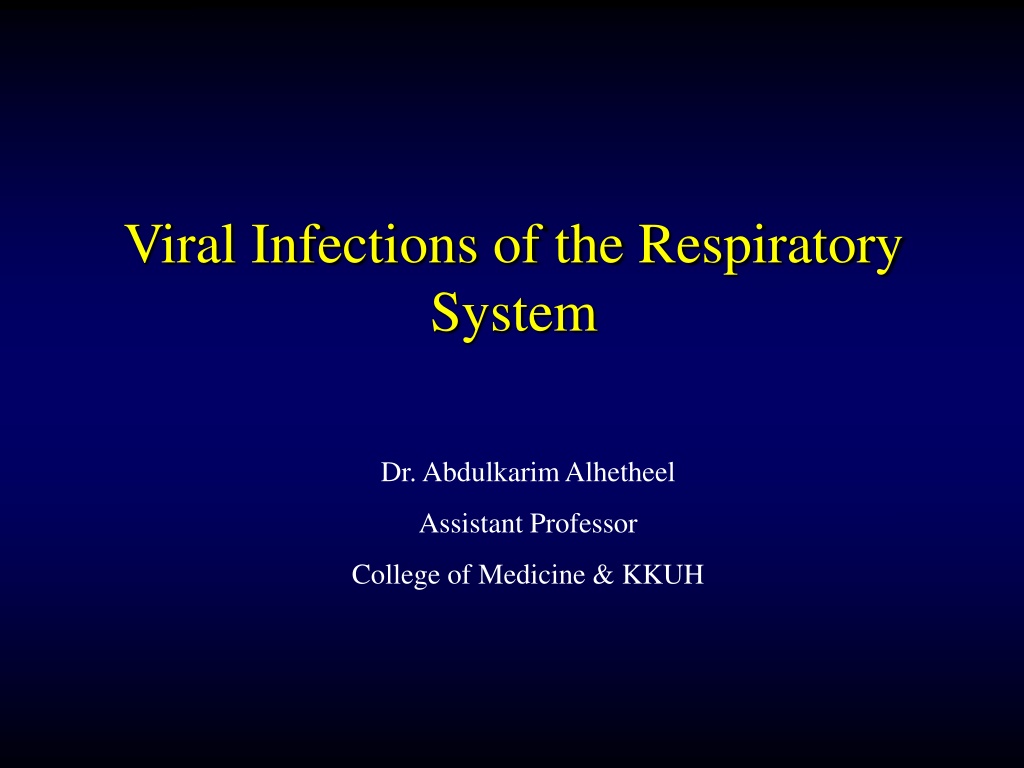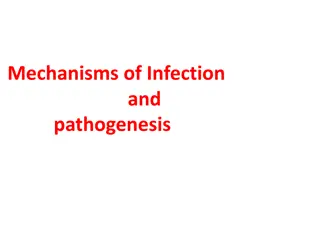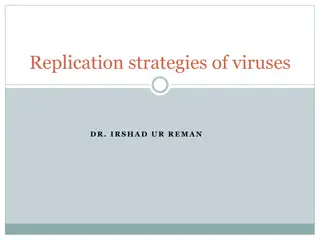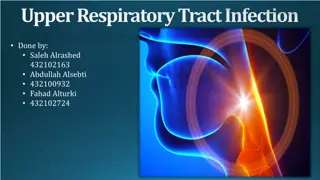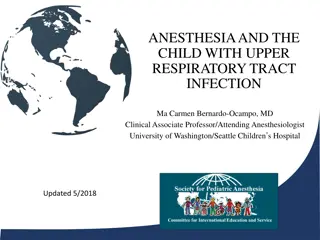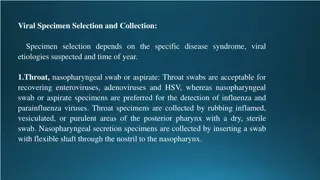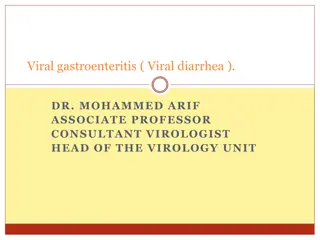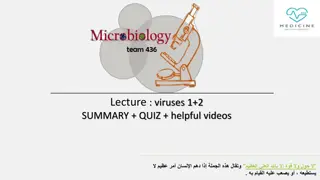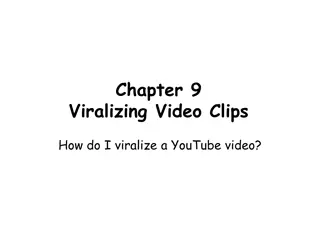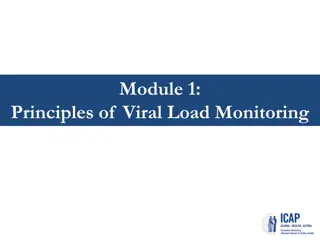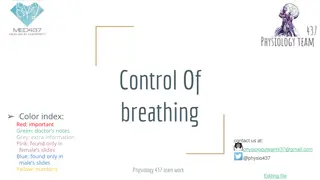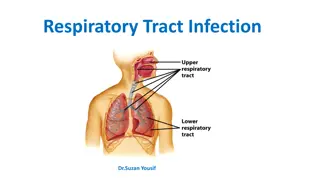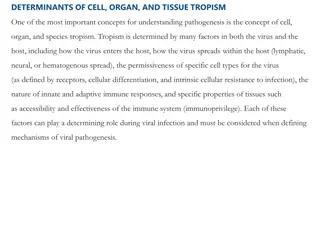Understanding Viral Infections of the Respiratory System
Respiratory viral infections are common and primarily caused by viruses, leading to morbidity and time off work. They can range from mild upper respiratory tract infections to severe lower respiratory tract infections like pneumonia. Various viruses like influenza, parainfluenza, respiratory syncytial virus, rhinovirus, coronavirus, adenovirus, and human metapneumovirus are responsible for different respiratory illnesses. This article discusses the characteristics, modes of transmission, clinical features, diagnosis, and management of these infections, with a focus on influenza virus and its structural features.
Download Presentation

Please find below an Image/Link to download the presentation.
The content on the website is provided AS IS for your information and personal use only. It may not be sold, licensed, or shared on other websites without obtaining consent from the author. Download presentation by click this link. If you encounter any issues during the download, it is possible that the publisher has removed the file from their server.
E N D
Presentation Transcript
Viral Infections of the Respiratory System Dr. Abdulkarim Alhetheel Assistant Professor College of Medicine & KKUH
Outline Introduction to respiratory viral infections Characteristics of respiratory viruses Mode of transmission Clinical features Lab diagnosis Management & treatment
Respiratory Tract Infections Are the commonest of human infections and cause a large amount of morbidity and loss of time at work (sick leave). Are common in both children and adults. Mostly caused by viruses. Mostly are mild and confined to the upper respiratory tract (URT). Mostly are self-limiting disease. URT-infection may spread to other organs causing more severe infection and death.
Clinical manifestations Common cold (rhinitis). Pharyngitis. Tonsilitis. Sinusitis & otitis media. Croup (acute laryngotracheobronchitis). Acute bronchitis. Acute bronchiolitis. Viral pneumonia. File:Illu conducting passages.svg
The common respiratory viruses. Name of the virus Family Disease 1-Influenza virus URT & LRT infection Orthomyxoviridae 2-Parainfluenza virus URT & LRT infection Paramyxoviridae 3-Respiratory syncytial virus LRT infection Paramyxoviridae 4-Rhinovirus URT infection Picornaviridae 5-Coronavirous URT & LRT infection Coronaviridae 6-Adenovirus URT and eye infections Adenoviridae 7-Human metapneumovirus LRT infection Paramyxoviridae Upper respiratory tract infection includes: rhinitis (common cold), tonsillitis, pharyngitis. Lower respiratory tract infection includes: croup, bronchitis, bronchiolitis, pneumonia.
1- Influenza Virus Family: Orthomyxoviridae. Structural features: Enveloped virus with 2 projecting glycoprotein spikes: Haemagglutinin (H) Neuraminidase (N) Genome: 8 Segmented - polarity ssRNA. This virus is highly susceptible to mutations and rearrangements within the infected host.
Influenza viral proteins Haemagglutinin (H): Attachment to the cell surface receptors. Antibodies to the HA is responsible for immunity. 16 haemagglutinin antigenic type, H1 H16. Human associated H antigenic type are H1, H2, H3. Neuraminidase (N): Responsible for release of the progeny viral particles from the infected cell. 9 neuraminidase antigenic type, N1 N9. Human associated N antigenic type are N1, N2.
Types of influenza virus A C B Infects human and Animal Infects human only Infects human only Causes epidemic & pandemic Causes mild illness Causes outbreak Causes epizootic in animal Antigenic drift only Antigenic drift minor change Antigenic shift major change
Influenza Virus Divided into subtypes based on the haemagglutinine and neuraminidase proteins. The currently circulating strains are: H1N1 & H3N2. Pathogenesis: The virus infects the epithelial cells of the nose, throat, bronchi and occasionally the lungs. Transmission: Inhalation of infectious aerosol droplets. I.P.: 1-4 days. Symptoms: Fever, malaise, headache, cough, chills, sore throat, and generalized pain. Prognosis: Usually self-limiting disease.
Continued.. Complications: - Primary influenza pneumonia - 2ndbacterial pneumonia - Reye s syndrome [fatty degeneration of CNS and Liver (Aspirin)] Lab diagnosis: routine testing by Direct detection of Influenza A or B virus from sputum, nasopharyngeal swab, aspirate (NPA) or respiratory secretion by direct immunoflourecent assay (IFA). Other detection methods: tissue culture, PCR. Treatment: 1: Amantadine is effective against influenza A virus only. 2: Rimantadine, Oseltamivir (Tamiflu) or Zanamivir (Relenza) are effective against both influenza A & B viruses and can be used as treatment and prophylaxis.
Continued.. Prevention: Influenza vaccine: Two types of vaccines available: 1- The flu shot vaccine: Inactivated (killed vaccine). Given to people older than 6-months, including healthy people and those with chronic medical conditions. 2- The nasal spray flue vaccine (Flu mist): Live attenuated vaccine. Approved for use in healthy people between 5-49 years of age. Both vaccines contain two strains of the current circulating influenza A virus and the current circulating strain of influenza B virus. Vaccine should be given in October or November, before the influenza season begins.
Avian flu Viral etiology: Avian influenza type A virus (H5N1). Family: Typical orthomyxovirus. Epidemiology: Wild birds are the natural reservoir for the virus. They shed the virus in saliva, nasal secretion and feces. All domestic poultry are susceptible to infection. They become infected, when they eat food contaminated with secretion or excretion from infected bird. Avian influenza viruses do not usually infect human. High risk group includes those who working in poultry farms and those who are in close contact with poultry.
Continued.. Symptoms in human: Ranges from typical flu to severe acute respiratory disease. Diarrhea, abdominal pain and bleeding from the nose have been reported. Treatment: Should be initiated within 48 hours. Oseltamivir and Zanamivir are used. Lab diagnosis: PCR, detection of the viral RNA in throat swap.
2- Parainfluenza Virus Family: Paramyxoviridae. Structural features: Enveloped virus with - polarity ssRNAgenome, with 5 serotypes. Transmission: Inhalation of infectious aerosol droplets mainly in winter. Clinical syndrome: a. Croup or acute laryngotracheobronchitis. PIV Type-I, II affect mainly in infants and young children. Fever, harsh cough, difficult inspiration can lead to airway obstruction which may require hospitalization and tracheostomy. b. Bronchiolitis and Pneumonia: PIV Type-III in young children.
Continued.. Lab diagnosis: routine testing by Direct detection of the virus from sputum, nasopharyngeal swab, aspirate (NPA) or respiratory secretion by direct immunoflourecent assay (IFA). Other detection methods: tissue culture, PCR. Treatment and prevention: Supportive treatment, No specific treatment or vaccine available.
3- Respiratory Syncytial Virus (RSV) Family: Paramyxoviridae. Structural features: Enveloped virus with - polarity ssRNAgenome. Transmission: Inhalation of infectious aerosols mainly in winter. Clinical syndromes: a. Bronchiolitis: Life-threatening disease in infant especially under 6 month of life with respiratory distress and cyanosis can be fatal and can lead to chronic lung disease in later life. b. Pneumonia: can also be fatal in infant.
Continued.. Lab diagnosis: routine testing by Direct detection of the virus from sputum, nasopharyngeal swab, aspirate (NPA) or respiratory secretion by direct immunoflourecent assay (IFA). Other detection methods: Isolated of virus by cell culture from N.P.A with multinucleated giant cell or syncytia as cytopathic effect (C.P.E); PCR. Treatment and prevention: Ribavirin administered by inhalation for infants with severe condition. Vaccine: No vaccine available, but passive immunization immunoglobulin can be given for infected premature infants.
4- Rhinovirus Family: Picornaviridae. Structural features: Non-enveloped virus with + polarity ssRNA genome, more than 100 serotypes available. Transmission: Inhalation of infectious aerosol droplets. Clinical symptoms: The 1stcause of common cold. The main symptoms of common cold are sneezing, clear watery nasal discharge with mild sore throat, and cough. Treatment and prevention: Usually self- limiting disease, no specific treatment, and no vaccine available.
5- Coronavirus Family: Coronaviridae. Structural features: Enveloped virus with + polarity ssRNA genome. Transmission: Inhalation of infectious aerosol droplets. Clinical symptoms: The 2ndcause of common cold. Corona virus can also cause severe respiratory diseases ( will be discussed in the 2ndlecture) Lab diagnosis: PCR or Tissue culture. Treatment and prevention: No specific treatment or vaccine available.
6-Adenovirus Family: Adenoviridae. Structural features: Non-enveloped virus with ds-DNA genome. Pathogenesis: Adenovirus infects epithelial cell lining respiratory tract, conjunctiva, urinary tract, gastrointestinal tract and genital tract. Clinical syndrome: 1. Phrayngitis and tonsilitis. 2. Pharyngioconjunctivitis 3. Conjunctivitis. 4. Pneumonia: in preschool children. 5. Gastroenteritis. 6. Acute hemorrhagic cystitis. 7. UTI (Cervicitis and urethritis). Lab diagnosis: routine testing by Direct detection of the Ag from NPA by direct IFA. Other detection methods: tissue culture, PCR. Treatment and prevention: No specific treatment or vaccine.
Reference books &the relevant page numbers Notes on Medical Microbiology By; Katherine N. Ward, A. Christine McCartney, and Bishan Thakker. (2009) Pages; 329-340. Human Virology By; Leslie Collier and John Oxford. (2006) Pages, 71-95.
Thank you for your attention! Questions?
